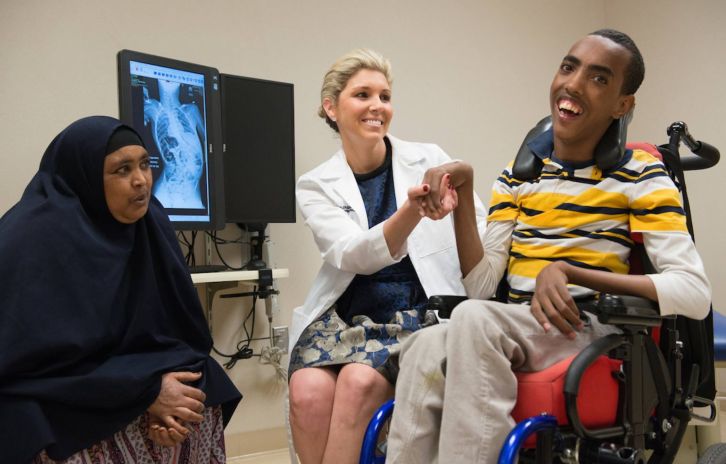
Spasticity is a muscular condition in which an atypical increase in muscle tone or stiffness reduces movement and may cause pain and discomfort. Commonly associated with conditions such as cerebral palsy and other disorders affecting the brain, spine, or motor neurons, spasticity causes muscles to tighten or stiffen and become resistant to stretching. When prolonged, spasticity can lead to contracture formation. Learn more about the differences between spasticity and contractures.
Andrea Paulson, MD, a physical medicine and rehabilitation physician and medical director of Gillette Children's Greater Minnesota clinics, outlines best practices for pediatric spasticity management.
Why Treat Spasticity?
The primary goal of spasticity management is to improve function. It also increases comfort, reduces contracture formation, and helps patients achieve developmental milestones. Effective spasticity management can minimize the long-term impact of neurological impairments. Desired outcomes from spasticity management will be as varied as the children served, but examples include mobility improvement, better hygiene, and an increased rate of weight gain.
Not all spasticity requires management. Children may sometimes use their spasticity to their advantage, such as when standing, walking, or transferring. The risk in managing spasticity too aggressively is the loss of the child's ability to use it in this way. The rehabilitation medicine experts at Gillette Children's are renowned for providing specialized, data-driven care for patients experiencing spasticity.
3 Main Methods of Pediatric Spasticity Management
The cornerstone of spasticity management is stretching. Along with bracing and physical therapy, stretching is the basis of good spasticity management regardless of an individual patient's treatment plan and goals. Range-of-motion exercises and prolonged stretching (often achieved with bracing) help to prevent contracture formation and reduce spasticity by decreasing input into stretch receptors. Beyond these foundational methods, spasticity management can take the form of oral medications, injections, or surgical interventions.
Oral Medications for Spasticity Management
Systemic or diffuse spasticity in children is often managed with oral medication. However, many antispasmodic medications come with side effects such as sedation. Therefore, slow upward titration of the medication is necessary to reduce side effects. Gillette's pediatric rehabilitation medicine providers have unmatched expertise in recommending the best titration plan for patients.
Common oral medications for spasticity management include:
| Name | Mechanism of Action |
|---|---|
| Baclofen | GABAB agonist; potentiates GABA |
| Dantrolene | Inhibits Ca release at the sarcoplasmic reticulum |
| Tizanidine | Alpha-2 agonist |
| Diazepam | GABAA agonist; potentiates GABA |
Managing Spasticity with Injections
The two primary injectable medications used in spasticity management are botulinum toxin and phenol. Each can be administered as the sole medication or used in conjunction with one another.
Botulinum toxin, an exotoxin, blocks the release of acetylcholine at the neuromuscular junction, weakening the muscle. When botulinum toxin is injected into a spastic muscle, it temporarily reduces tone. Botulinum toxin has a one- to three-day onset window following injection, with peak response at one to two weeks. The effects last approximately three months.
Phenol is an alcohol with strong proteolytic properties. When injected into a motor neuron, chemical neurolysis results, denervating the muscle. This denervation, in turn, decreases spasticity by decreasing both the efferent input into the muscle and the afferent impulses from the muscle spindle. Localization of phenol injection is critical, as it does not readily diffuse through tissue. Phenol blocks have a faster onset and length of effectivity than botulinum toxin, with the effects felt almost immediately and lasting four to twelve months.
Side Effects of Spasticity Medication
Both oral and injectable spasticity medications come with the possibility of side effects.
Baclofen: drowsiness, weakness, constipation
Dantrolene: less sedating, weakness, hepatotoxicity
Tizanidine: sedation
Diazepam: sleepiness, impaired cognition, respiratory depression
Botulinum toxin: injection site pain, localized weakness; rarely respiratory problems, excessive weakness, dysphagia
Phenol: numbness and tingling
Surgical Options for Spasticity Management
Surgical options for managing spasticity include the implantation of an intrathecal baclofen pump or a selective dorsal rhizotomy.
When taken orally, baclofen does not efficiently cross the blood-brain barrier. An intrathecal baclofen (ITB) pump allows the baclofen to be delivered directly into the cerebrospinal fluid, bypassing the blood-brain barrier altogether. Implanted subcutaneously in the abdomen with a catheter passing under the skin and into the intrathecal space, an ITB pump can treat both dystonia and spasticity. After placement, baclofen is injected into the pump using a needle in a clinic setting. The pump is then programmed according to the spasticity management needs of the individual patient to deliver specified doses of baclofen at designated times. The pump requires refilling every few months and should be replaced every five to seven years in the interest of battery life. Complications associated with an intrathecal baclofen pump include infection, catheter malfunction, CSF leakage, and, rarely, pump failure. The most life-threatening complication related to the ITB pump is acute baclofen withdrawal, which must be addressed immediately.
In a selective dorsal rhizotomy (SDR), 25-60% of dorsal rootlets in the lumbar vertebra 1 (L1) through sacral vertebra 1 (S1) or 2 (S2) are accessed via laminectomy at the conus medullaris or the cauda equina. The sensory rootlets are stimulated and cut while the motor fibers are left intact. This disrupts the monosynaptic reflex arc, reducing spasticity while preserving movement. SDR's most common side effects include pain, tingling, and itching post-surgery. Due to the handling of sensory nerve rootlets during SDR, dysesthesia (hypersensitivity, particularly to touch) is another common--but temporary--side effect.
There are myriad ways to manage spasticity in children, varying from basic medication management to more involved surgical options. Treatments can be used alone or in conjunction with other therapies. By evaluating each child with consideration for their unique conditions, needs, and health status, spasticity can be successfully managed and contribute to a greater quality of life for the children affected.



